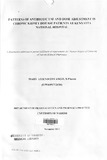| dc.contributor.author | Onyango, Mary A | |
| dc.date.accessioned | 2013-05-23T13:10:40Z | |
| dc.date.available | 2013-05-23T13:10:40Z | |
| dc.date.issued | 2011 | |
| dc.identifier.citation | Masters Degree Of University Of Nairobi (clinical Pharmacy,2011 | en |
| dc.identifier.uri | http://erepository.uonbi.ac.ke:8080/xmlui/handle/11295/24931 | |
| dc.description.abstract | Background: Patients with reduced renal function are often encountered in clinical practice. The presence of reduced kidney function in any patient alters drug disposition. This alteration necessitates appropriate individualization of drug therapy to avoid unnecessary drug accumulation and adverse drug effects. There are limited local studies on the pattern of antibiotic use and dose adjustments in renal patients and hence the basis of the current study.
Objective of the study: The objective of the study was to determine the patterns of antibiotic use and dose adjustment practices in patients with chronic kidney disease (CKD) at Kenyatta National Hospital (KNH).
Methodology: The study was hospital-based retrospective cross sectional study. A pre formatted data collection form was used to collect data from patient files who met the eligibility criteria.
Data was collected on antibiotics prescribed to patients with CKD between. January. 2006 and December, 2010 and the laboratory parameters of renal function. The antibiotic dosage for systemic administration, which ought to have been adapted depending on the GFR. was determined from the dosing guideline and this was compared with the prescribed dosages to determine the appropriateness of the prescribed doses.
Eligibility criteria: Chronic kidney disease patients, with antibiotic prescription and aged 18
years and above during the time of antibiotic prescription attending KNH during the study period were eligible for the study.
Data analysis: Estimated glomerular filtration rate (GFR) was calculated using the Modification of Dietin Renal Disease four variable (MDRD) equation. Data analysis was done using STATA version9 statistical software. Data was subjected to descriptive, confounding and logistic regression analysis.
Results: The median age at diagnosis of CKD in the study population was 46 years (IQR=32 - 60 years). There were slightly more males (57.3%) than females in the study. Ceftriaxone and co-amoxiclavwere the most frequently prescribed antibiotics. The most important risk factor for inappropriate dose adjustment was the severity of renal disease. Dose adjustment was indicated in 59.9% of antibiotic prescriptions; however appropriate adjustment was only done in 27.7% (95%CI 23.18 - 32.23) of the prescriptions. Coamoxiclav was the least frequenyly adjusted antibiotic with only 8.5% appropriate adjustment whereas, vancomycin had the' highest prevalence of correct dose adjustment at 69.7% of the prescriptions that required adjustment.
Over dosage was the most common dosing error. Therapeutic drug monitoring was neither requested nor done for any of the prescribed antibiotics considered in the study.
Conclusion: Antibiotic dose adjustment in patients with CKD was often incorrect especially for co-amoxiclav. Strategies to improve prescribing of drugs such as, development of a simplified guide for dose adjustment of commonly used drugs and pharmacist involvement in drug therapy monitoring should be considered. | en |
| dc.language.iso | en | en |
| dc.publisher | University of Nairobi | en |
| dc.title | Patternsof antibiotic use and dose adjustment in chronic kidney disease patients at Kenyatta National Hospital | en |
| dc.type | Thesis | en |
| dc.description.department | a
Department of Psychiatry, University of Nairobi, ; bDepartment of Mental Health, School of Medicine,
Moi University, Eldoret, Kenya | |
| local.publisher | Department Of Pharmaceutics And Pharmacy Practice | en |

